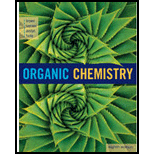
Concept explainers
(a)
Interpretation:
The standard enthalpy of reaction has to be calculated using the values of bond dissociation enthalpies.
Concept Introduction:
The value of standard enthalpy change
Where,
(a)
Explanation of Solution
Given reaction (1):

The reaction is given below:
Therefore, standard enthalpy of given reaction is
Given reaction (2):

The reaction is given below:
Therefore, standard enthalpy of given reaction is
(b)
Interpretation:
A pair of chain propagation steps for each reaction has to be proposed; the value of
Concept Introduction:
Radical Bromination: A type of halogenation reaction in which the bromine atom gets bonded with the
Radical reaction of
Stability of Radicals: Radicals are highly unstable due to its unpaired valence electron of an atom.
The increasing order of radical stability is given below,
Benzylic > allylic > tertiary > secondary > primary > methyl
Radical chain reaction:
Initiation reaction: 
Chain propagation: 
Chain termination:
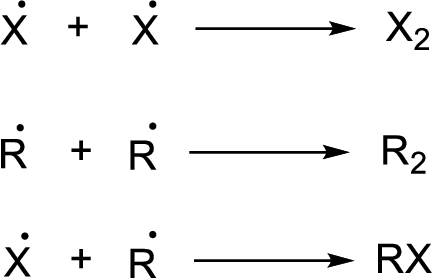
(b)
Explanation of Solution
Given reaction (1):
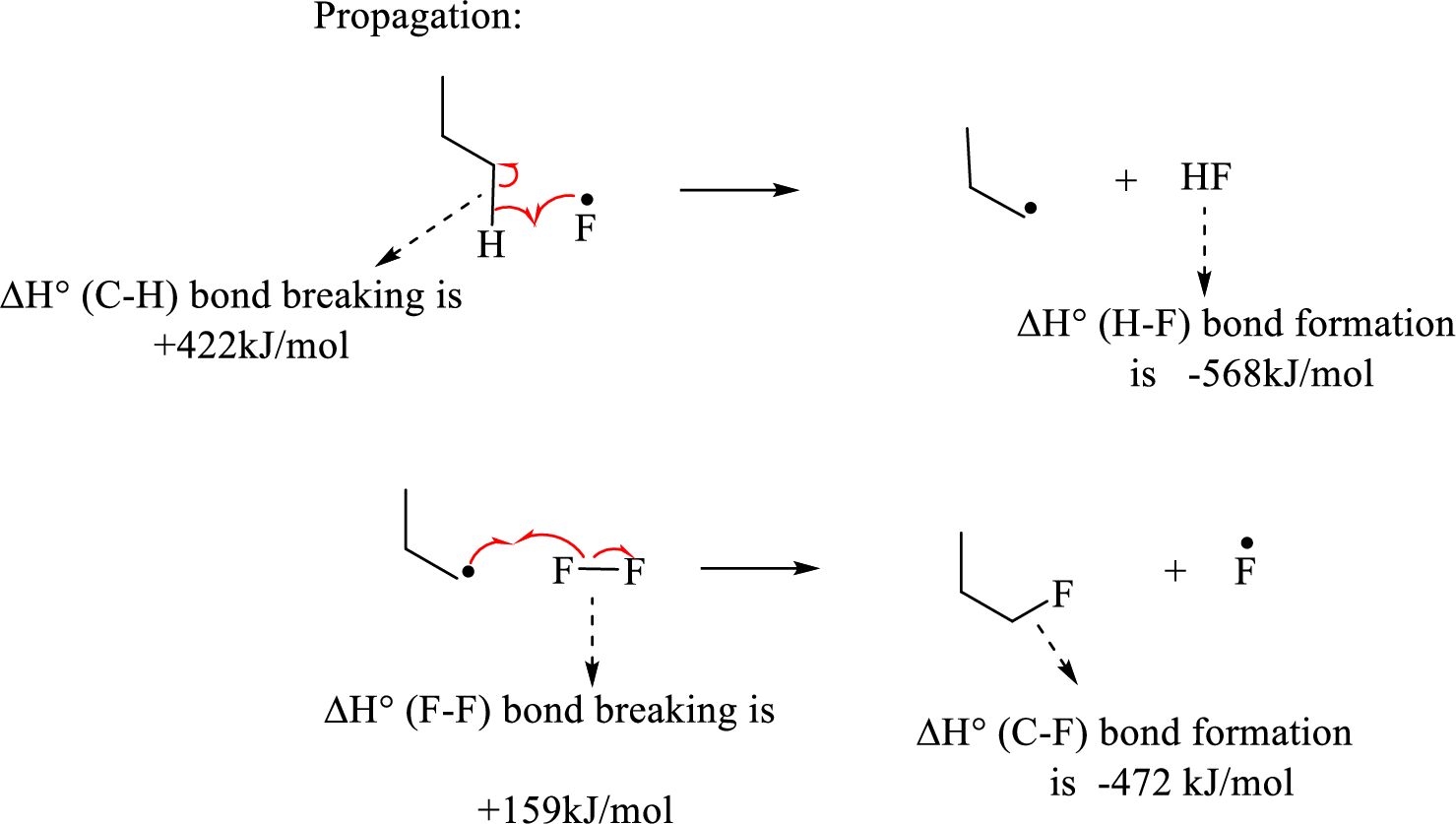
The propagation step involves extremely reactive fluorine radicals react towards the propane by abstracting the terminal hydrogen forming primary radical and
Hence, the pair of propagation steps is shown above.
Given reaction (2):
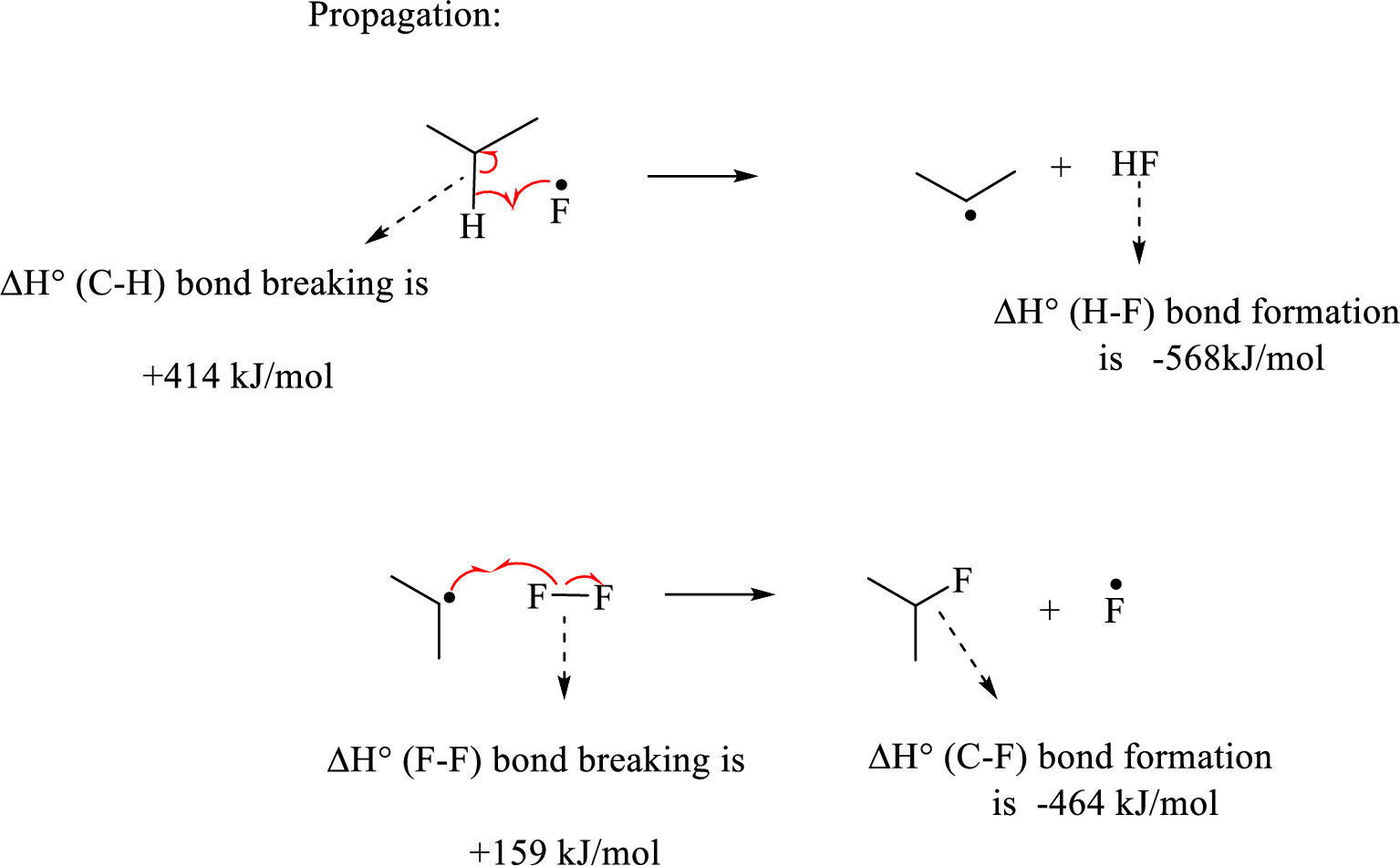
Initiation step involves the homolytic bond cleavage of fluorine molecule by irradiation of light or heat leads to the formation of two Fluorine radicals.
The propagation step involves extremely reactive fluorine radicals react towards the propane by abstracting the secondary hydrogen forming secondary radical and
Hence, the pair of propagation steps is shown above.
Therefore, for each reaction step the value of
(c)
Interpretation:
The regioselectivity of radical fluorination relative to that of radical chlorination and Bromination has to be predicted using Hammond’s postulate.
Concept Introduction:
Radical Bromination: A type of halogenation reaction in which the fluorine atom gets bonded with the alkane or alkyl substituents resulting to the product with added fluorine atom via radical mechanism.
Radical reaction of
Stability of Radicals: Radicals are highly unstable due to its unpaired valence electron of an atom.
The increasing order of radical stability is given below,
Benzylic > allylic > tertiary > secondary > primary > methyl
Radical chain reaction:
Initiation reaction: 
Chain propagation: 
Chain termination:
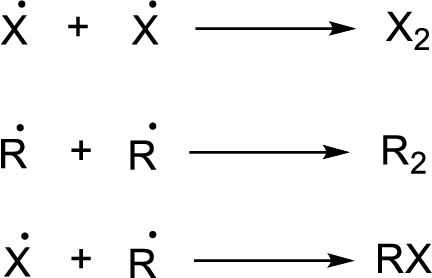
(c)
Explanation of Solution
In each radical fluorination sequence, the hydrogen abstraction step is highly exothermic, thus the transition state is reached too early and the transition state more closely resembles the reactant; so the intermediate has very little radical character of product. Therefore, the relative stabilities of primary versus secondary radical is of little of importance in determination of product.
Want to see more full solutions like this?
Chapter 8 Solutions
BNDL: ACP ORGANIC CHEMISTRY:CH EM 231(W/ACCESS CARD)
- Determine if the following salt is neutral, acidic or basic. If acidic or basic, write the appropriate equilibrium equation for the acid or base that exists when the salt is dissolved in aqueous solution. If neutral, simply write only NR. Be sure to include the proper phases for all species within the reaction LiNO3arrow_forwardAn unknown weak acid with a concentration of 0.410 M has a pH of 5.600. What is the Ka of the weak acid?arrow_forward(racemic) 19.84 Using your reaction roadmaps as a guide, show how to convert 2-oxepanone and ethanol into 1-cyclopentenecarbaldehyde. You must use 2-oxepanone as the source of all carbon atoms in the target molecule. Show all reagents and all molecules synthesized along the way. & + EtOH H 2-Oxepanone 1-Cyclopentenecarbaldehydearrow_forward
- R₂ R₁ R₁ a R Rg Nu R₂ Rg R₁ R R₁₂ R3 R R Nu enolate forming R₁ R B-Alkylated carbonyl species or amines Cyclic B-Ketoester R₁₁ HOB R R₁B R R₁₂ B-Hydroxy carbonyl R diester R2 R3 R₁ RB OR R₂ 0 aB-Unsaturated carbonyl NaOR Aldol HOR reaction 1) LDA 2) R-X 3) H₂O/H₂O ketone, aldehyde 1) 2°-amine 2) acid chloride 3) H₂O'/H₂O 0 O R₁ R₁ R R₁ R₁₂ Alkylated a-carbon R₁ H.C R₁ H.C Alkylated methyl ketone acetoacetic ester B-Ketoester ester R₁ HO R₂ R B-Dicarbonyl HO Alkylated carboxylic acid malonic ester Write the reagents required to bring about each reaction next to the arrows shown. Next, record any regiochemistry or stereochemistry considerations relevant to the reaction. You should also record any key aspects of the mechanism, such as forma- tion of an important intermediate, as a helpful reminder. You may want to keep track of all reactions that make carbon-carbon bonds, because these help you build large molecules from smaller fragments. This especially applies to the reactions in…arrow_forwardProvide the reasonable steps to achieve the following synthesis.arrow_forwardIdentify which compound is more acidic. Justify your choice.arrow_forward
- Provide the reasonable steps to achieve the following synthesis.arrow_forwardWhen anisole is treated with excess bromine, the reaction gives a product which shows two singlets in 1H NMR. Draw the product.arrow_forward(ii) Draw a reasonable mechanism for the following reaction: CI NaOH heat OH (hint: SNAr Reaction) :arrow_forward
 Organic ChemistryChemistryISBN:9781305580350Author:William H. Brown, Brent L. Iverson, Eric Anslyn, Christopher S. FootePublisher:Cengage Learning
Organic ChemistryChemistryISBN:9781305580350Author:William H. Brown, Brent L. Iverson, Eric Anslyn, Christopher S. FootePublisher:Cengage Learning
